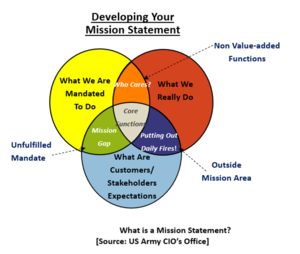Mission Statement
A mission statement is a concise explanation of the organization's reason for existence. It describes the organization's purpose and its overall intention. The mission statement supports the vision and serves to communicate purpose and direction to employees, customers, vendors and other stakeholders.[1]
A mission statement is used by a company to explain, in simple and concise terms, its purpose(s) for being. The statement is generally short, either a single sentence or a short paragraph. The statement serves a dual purpose by helping employees remain focused on the tasks at hand, as well as encouraging them to find innovative ways of moving toward an increasingly productive achievement of company goals. A company’s mission statement defines its culture, values, ethics, fundamental goals, and agenda. Furthermore, it defines how each of these applies to the company's stakeholders — its employees, distributors, suppliers, shareholders, and the community at large — use this statement to align their goals with that of the company. The statement reveals what the company does, how it does it, and why it does it. Prospective investors may also refer to the mission statement to see if the values of the company align with theirs. For example, an ethical investor against tobacco products would probably not invest in a company whose mission is to be the largest global manufacturer of cigarettes. It is not uncommon for the largest companies to spend many years and millions of dollars to develop and refine their mission statements. In some cases, many mission statements eventually become household phrases.[2]
Developing a Mission Statement
Mission statements are found in the intersection of three organizational areas:
- Mandates;
- Customer and Stakeholder Expectations, and
- What Is Really Being Done.
An organization’s true mission is found at the intersection of those three areas [see Figure below]:
The real “mission” of an organization is found at the center of the graphic, at the intersection of all three areas; this is the area where senior leadership can say “We are mandated by law to do this, and it’s expected of us by our customers and stakeholders and we are doing it.” That is really the baseline function. That is really the mission of the organization.
However, in taking an example of cyberspace organizations the real mission would be somewhere other than in the center area. To further explain…
- If an organization is mandated to do something and if customers/stakeholders expect it, but the organization is not doing it, then we have an unfulfilled mandate [mission gap]
- If an organization is mandated to do something and the organization is doing it but customers/stakeholders don’t expect the organization to do it, then we have an example of a non-value added function [who cares]
- If customers/stakeholders expect the organization to do something and the organization is doing that something but the organization is not mandated to do it, then we have an example of something outside the mission area [senior leadership putting out daily fires]
In the case of public sector cyber space organizations, this would mean to seek innovative approaches to improve cyber capability against growing threats and avoiding performance metrics used to demonstrate progress that are narrowly focused and fail to capture the progress made to improve cybersecurity.
- ↑ Definition - What Does a Mission Statement mean? SHRM
- ↑ Understanding Mission Statement Investopedia

